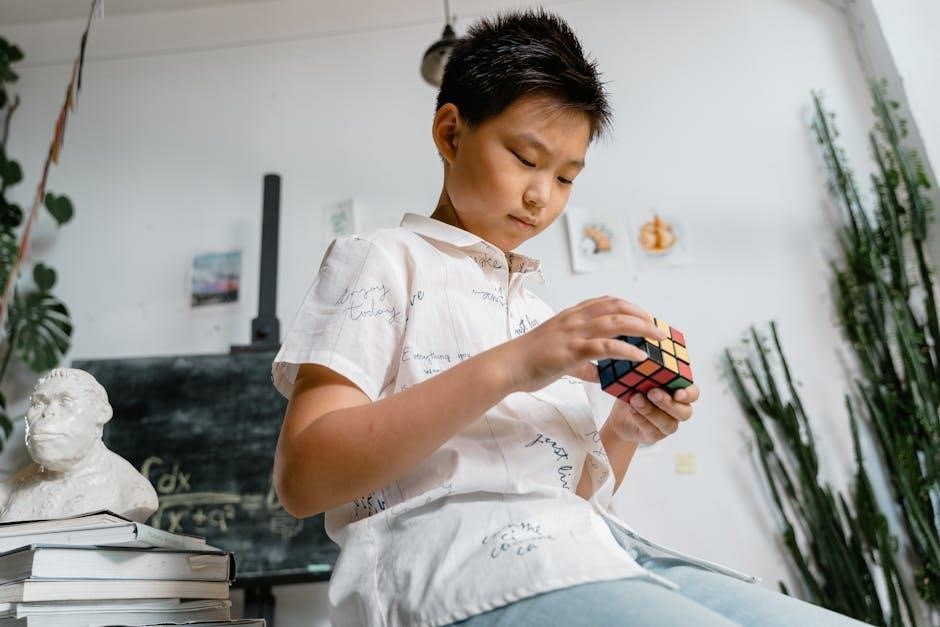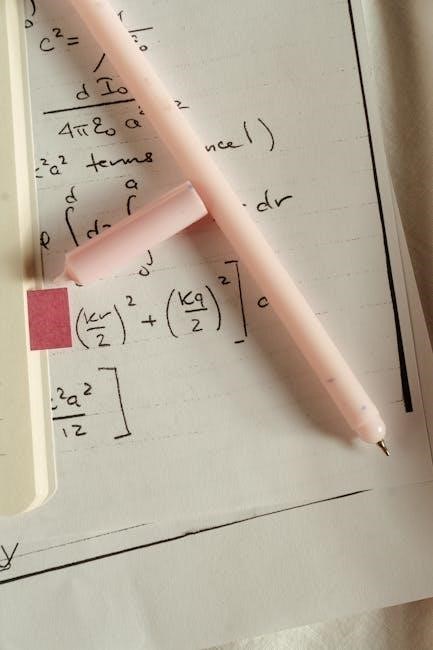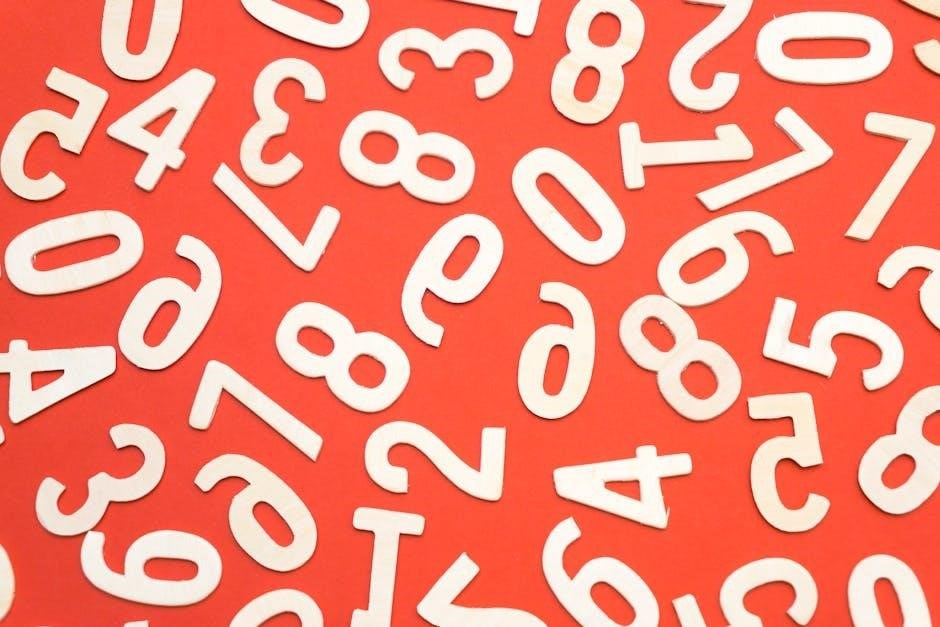
Jo Boaler’s Mathematical Mindsets revolutionizes math education by emphasizing growth mindsets, creativity, and visualization. Her research challenges fixed-ability beliefs, promoting a mindset shift for deeper mathematical understanding.
Overview of the Concept and Its Importance
Jo Boaler’s Mathematical Mindsets introduces a transformative approach to mathematics education, emphasizing the importance of mindset shifts in learning. The concept highlights the brain’s remarkable ability to grow and adapt, challenging traditional fixed-ability beliefs. By fostering a growth mindset, students can overcome math anxiety and develop a deeper understanding of mathematical concepts. Boaler’s work underscores the critical role of creativity, visualization, and problem-solving in engaging students and promoting equity in education. This approach not only addresses disparities in math performance but also empowers teachers with practical strategies to create inclusive and inspiring learning environments. The importance lies in its potential to redefine how mathematics is taught and perceived, fostering a love for learning that extends beyond the classroom.

The Concept of Fixed Ability vs. Growth Mindset in Mathematics
Jo Boaler’s work contrasts fixed ability beliefs, which assume math talent is innate, with growth mindsets, emphasizing effort and learning to unlock mathematical potential and equity.
How Fixed Ability Thinking Limits Student Potential
Fixed ability thinking assumes mathematical talent is innate, restricting students’ belief in their potential. This mindset leads to fear of mistakes, hesitancy to ask questions, and a reluctance to engage deeply with math. When students believe their abilities are fixed, they often avoid challenges, fearing failure will reveal their perceived limitations. This mindset not only stifles creativity and problem-solving but also discourages persistence, a crucial trait for math success. By limiting opportunities for growth, fixed ability thinking perpetuates inequality, particularly for underrepresented groups. It creates a self-fulfilling prophecy, where students who doubt their abilities perform poorly, reinforcing their negative beliefs about their math potential.

The Role of Growth Mindset in Mathematics Education
A growth mindset transforms mathematics education by fostering resilience, creativity, and confidence. Unlike fixed ability thinking, it emphasizes that math skills can be developed through effort and perseverance. When students embrace a growth mindset, they view challenges as opportunities to learn and mistakes as stepping stones to understanding. This shift encourages deeper engagement and problem-solving, leading to improved performance and a genuine enjoyment of math. Teachers play a vital role by creating environments where effort is valued, and growth is celebrated. By promoting a growth mindset, educators empower students to overcome math anxiety and unlock their full potential, regardless of their background or prior experience.

Key Principles of Mathematical Mindsets
Jo Boaler’s Mathematical Mindsets emphasize the brain’s growth potential, the power of mistakes, and the importance of creativity and visualization in math learning and understanding.
The Brain’s Potential for Growth and Change
Jo Boaler’s work highlights the brain’s remarkable ability to grow and adapt, challenging the notion of fixed mathematical ability. Neuroscience shows that neural connections expand with practice, proving math skills can improve. Boaler emphasizes that every mistake fosters brain development, creating new pathways for understanding. This concept encourages students to embrace challenges, viewing them as opportunities for growth rather than failure. By shifting this mindset, educators can help students overcome limitations and build confidence in their mathematical abilities. Boaler’s research underscores the importance of nurturing a growth mindset to unlock each student’s full potential in mathematics. This approach transforms math education, making it inclusive and empowering for all learners.
The Power of Mistakes in Learning Mathematics

Jo Boaler’s research underscores the transformative role of mistakes in mathematical learning. When students make errors, their brains form new neural connections, enhancing understanding. Mistakes are not failures but opportunities for growth, fostering resilience and deeper conceptual grasp. Boaler advocates for classrooms where errors are celebrated as stepping stones to mastery. By reframing mistakes as learning tools, educators can reduce math anxiety and encourage students to view challenges as solvable puzzles. This approach shifts the focus from perfection to progress, empowering students to embrace problem-solving with confidence and curiosity. Mistakes, therefore, become a cornerstone of a growth-oriented math education, unlocking students’ potential.
Encouraging Creativity and Visualization in Math
Jo Boaler’s work highlights the importance of creativity and visualization in math education. By engaging students in open, visual, and creative tasks, educators can help them see mathematics as a flexible, interpretable subject. Visualization tools, such as drawings or manipulatives, allow students to explore complex concepts intuitively. Creativity fosters a deeper connection to math, encouraging students to approach problems with curiosity and confidence. Boaler emphasizes that visual and creative methods can break down barriers for students who struggle with traditional numeracy. By integrating art, storytelling, and real-world applications, teachers can make math more accessible and meaningful, unlocking students’ creative potential and fostering a lifelong love for learning.

Practical Strategies for Teachers

Boaler suggests structuring math problems with open, visual tasks to encourage creativity and deeper understanding, fostering engagement and accessibility for all learners.
Structuring Math Problems to Promote Deep Understanding
Jo Boaler advocates for structuring math problems that encourage creativity and critical thinking. She suggests using open, visual, and real-world tasks that allow students to explore multiple solutions and approaches. These problem designs help students connect mathematical concepts to practical scenarios, fostering engagement and accessibility. Incorporating visual elements like graphs and diagrams can also enhance understanding for diverse learners. Additionally, Boaler emphasizes the importance of “low-floor, high-ceiling” tasks, which are accessible to all students but offer depth for further exploration. This approach promotes a growth mindset, encouraging students to view challenges as opportunities for growth rather than obstacles. By integrating these strategies, educators can create a more inclusive and effective math learning environment.
Guiding Students Through Problem-Solving Processes
Jo Boaler emphasizes the importance of guiding students through problem-solving processes by fostering inquiry-based learning and collaboration. Teachers should act as facilitators, encouraging students to explore and explain their reasoning. Open questioning and visual aids can help students connect abstract concepts to tangible solutions. Boaler suggests using “mathematical modeling” to allow students to investigate real-world problems, fostering a deeper understanding of math. Providing constructive feedback and celebrating mistakes as learning opportunities further supports this approach. By guiding students in these ways, educators empower them to develop resilience, creativity, and a growth mindset, equipping them to tackle complex challenges with confidence and critical thinking skills.

The Impact of Mathematical Mindsets on Student Achievement
Jo Boaler’s research highlights that adopting a growth mindset significantly boosts student achievement by overcoming math anxiety, fostering confidence, and enhancing problem-solving skills;
Breaking Down Math Anxiety and Building Confidence
Jo Boaler’s work emphasizes that math anxiety stems from fixed mindset beliefs and fear of failure. By reframing mistakes as opportunities for growth, students can overcome these barriers. Boaler advocates for open, visual, and creative math tasks that reduce pressure and foster confidence. Her strategies, such as encouraging self-reflection and peer discussion, help students develop a more positive relationship with mathematics. By shifting the focus from speed and accuracy to deep understanding, Boaler’s approach empowers students to view math as a subject where effort and persistence lead to success, rather than innate ability. This mindset transformation is key to building resilience and confidence in learners.
Creating a Positive and Inclusive Math Environment
Jo Boaler’s approach emphasizes the importance of fostering a positive and inclusive math environment. This involves creating classrooms where all students feel valued, challenged, and supported. By using open-ended, visual, and creative math tasks, teachers can encourage collaboration and reduce competition. Boaler suggests that inclusive practices, such as group work and peer discussion, help students see mathematics as a collective effort rather than an individual struggle. Additionally, teachers should celebrate mistakes as learning opportunities, promoting a growth mindset. This shift in classroom culture not only enhances student engagement but also ensures that diverse learners thrive, breaking down barriers to mathematical understanding and confidence.
Jo Boaler’s work transforms mathematics education by shifting mindsets, fostering creativity, and empowering students to embrace challenges, ensuring a brighter, more inclusive future for math learners worldwide.

Transforming Mathematics Education Through Mindset Shifts
Jo Boaler’s groundbreaking work highlights the transformative power of mindset shifts in mathematics education. By embracing growth mindsets, students and educators can break free from the constraints of fixed-ability thinking, fostering a more inclusive and creative learning environment. Boaler’s research emphasizes the brain’s remarkable potential for growth, illustrating how mistakes and challenges serve as catalysts for deeper understanding. Her innovative teaching strategies, such as structuring math problems to promote deep thinking and encouraging visualization, empower students to view math as a dynamic and accessible subject. This mindset shift not only enhances academic achievement but also builds confidence and a lifelong love for learning mathematics, creating a ripple effect that extends far beyond the classroom.